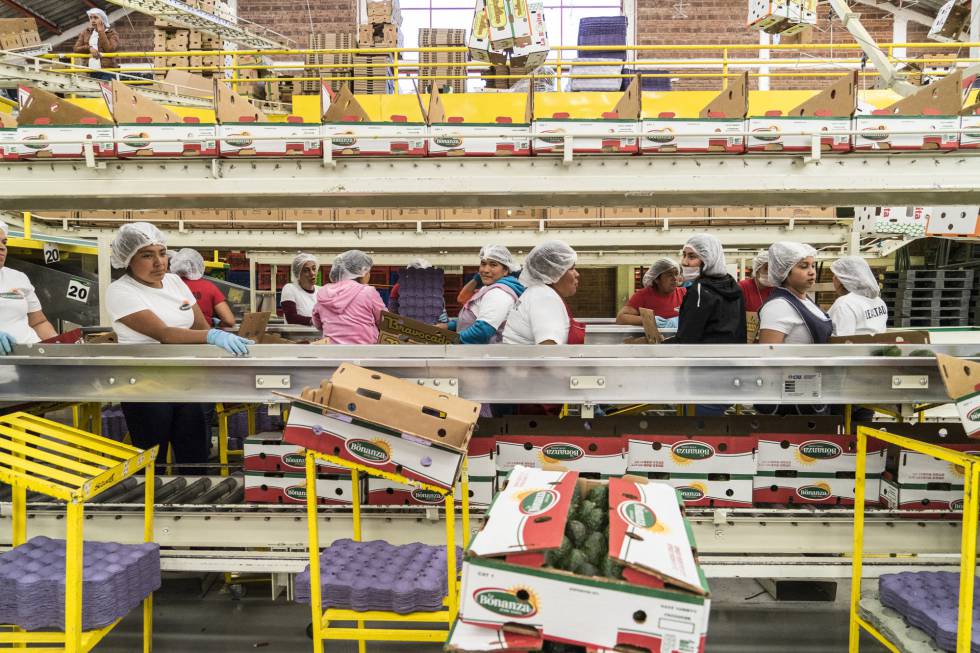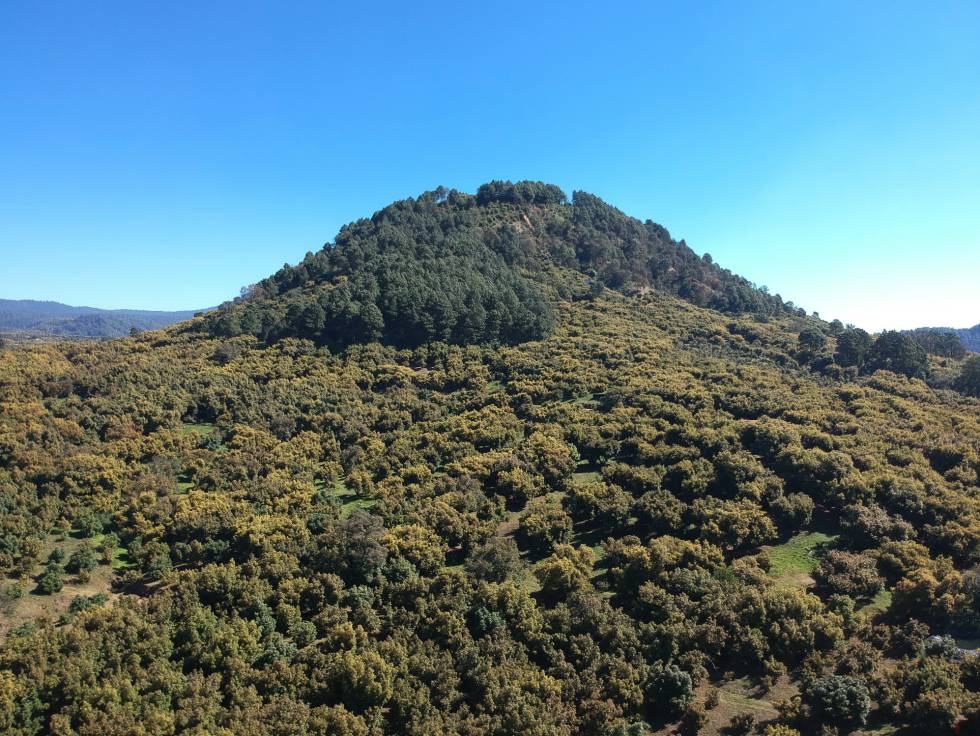 |
| A worker collects avocados from a farm in Uruapan. GLADYS SERRANO |
The curse of the Mexican avocado
The state of Michoacán is the world’s top producer of the fruit but the commercial boom for the superfood has brought with it violence, deforestation and job insecurity
La loca is to blame. When you walk up the hill, you spy little white designer homes built in the Bauhaus style and wineries with English-sounding names. Even higher up, everything turns a pale green as the buildings make way for a forest of trees filled with small yellowish flowers with five petals each. Mexican growers call this flower la loca (the crazy one) because it is unpredictable: it can bloom any time it wants, in summer or winter.
Crazy flowers all year long also means avocados all year long. This unbeatable pace of growth makes these the most productive fruit trees on the planet. Because of its altitude, climate and soil, the Mexican state of Michoacán is pure avocado heaven.
They grow by themselves around here. But a lot more have been planted in recent years, and it’s changed everyone’s lives
JOSÉ LUIS MATA, GROWER
“They grow all by themselves around here. But a lot more have been planted in recent years, and it’s changed everyone’s lives,” says José Luis Mata, standing on the green hill overlooking Uruapan. Around two decades ago, Mata quit growing cucumbers to focus on melons, and later dropped these for avocados.
Americans are hooked on avocados from Michoacán, the only Mexican state that is authorized to sell the product to its northern neighbor. Exports have grown fourfold in the last decade, and sales to the US last year were in the neighborhood of $2.5 billion. That is more than the proceeds from oil. And the surface area devoted to avocado plantations has expanded by 200%. It is as though the entire city of London had turned into one enormous avocado orchard.
Uruapan, population 300,000, is at the heart of Michoacán’s avocado business. All the main suppliers are here, and this is where the contradictory effects of the industry can be most clearly felt: the Bauhaus designer homes and the tin-roof shacks, the foreign companies and the razed forests, the expensive guacamole ads shown at the Superbowl and the people gunned down on the street.

A veteran distributor who wished to remain anonymous explains how his son was murdered a week ago outside right outside the company building. The victim had just finished work and was heading home when he was approached by two armed men on a motorcycle who shot him point blank. “I had already left work. I got a phone call and rushed back. I got there in time to see him bleeding to death on the doorstep,” says the businessman, standing inside his office as he supervises a truck shipment. His son, a 26-year-old business graduate, was still learning the ropes of the business.
“Other entrepreneurs in this industry are being asked for payments again. Not us, although some negotiations with mediators have ended with a gun on the table,” he says.
This avocado-growing area suffered a spike in organized crime violence around five years ago. Attracted by the easy money, the dominating crime cartels at the time – La Familia Michoacana and Los Caballeros Templarios (The Knights Templar) – demanded a share of the pie through extortion and physical assault.

They came into the mountain villages and invaded the fields, kicking the growers out of their own land. Organized civilian self-defense groups and the fall of the big drug lords reduced the pressure, and media attention moved to other hot spots in the country. But the violence never went away.
“In Uruapan, because it’s more of a city, there were no self-defense groups. Earlier, at least we knew who they were. Now we don’t even know,” adds the entrepreneur.
In 2014, the man who was then the president of the Association of Avocado Producers and Packers of Michoacán (APEAM), Sergio Guerrero Urbina, stepped down after being caught on video chatting with Servando Gómez La Tuta, leader of the Caballeros Templarios gang, together with other businessmen and local politicians.
Gabriel Villaseñor, the current president of the industry association, says that back at the time you would “get called” to a meeting under death threats. He says that the tension has died down, but notes there has been a rise in robberies, assault and murder, which he blames on petty criminals. He himself hired bodyguards after his own cousin was murdered two years ago.
There is money to pay for multimillion ads at the Superbowl, but not for research
INIFAP
While the interview is taking place, a pair of antlers suddenly materializes outside the office window. “They are albino fallow deer. I really like animals. I once had African antelope, but I think that because of the cold climate here they got the flu and died,” he says. Each pair of deer cost him around $1,000.
Inside Villaseñor’s factory La Bonanza, one of the oldest in the area, the pace of work is frenzied. This is a particularly busy week because demand for the fruit soars during Superbowl weekend. Over 100 workers are slicing, cleaning and storing avocados. The working day is 7am to 7pm, for $130 a week.
In Uruapan, 51% of residents are poor, according to official figures from 2016. In November, the entire production chain was halted for nearly three weeks because of a protest by producers, who felt that distributors were bringing prices down by letting in produce from other states. The price of a kilogram fell to 17 pesos (€0.77) from highs of 90 pesos. The APEAM denies the existence of fruit from outside Michoacán, and says the price change was caused by market fluctuations: greater production means lower prices.
Day laborers, the weakest link
Stuck in the middle are the laborers, the weakest link in the chain. “If we don’t cut, we don’t eat,” says Francisco Hinojosa, 50, armed with a pair of pruning shears to collect the fruit from the tree. He says that years ago they used to work directly for the distributors, with a contract, health insurance and benefits. Now, they work for subcontractors at hourly rates. He earns around $30 for five hours of work. In the afternoon he does odd jobs to make ends meet: bricklaying, gardening, plumbing.
At the top of the hill, there is still a strip of pine forest left. The boundaries with the avocado orchards are not clearly defined, and a line of fruit trees juts into the pine grove. “They were clearing and planting, but the government found out and put a stop to it,” says a local.
There are no official or even reliable statistics on the deforestation caused by intensive avocado growing in Mexico. “There are around 180,000 hectares,” figures the director of the Michoacán office of the National Forest Research Institute (INIFAP), a federal agency. “There’s been abuse, but nothing serious. The problem is that we have no studies to measure the impact of this deforestation. There are no incentives to fund research that could harm the industry’s interests. There is money to pay for multimillion ads at the Superbowl, but not for this.”
This will be the fifth year in a row that the US branch of APEAM runs an avocado ad at the most expensive US sports event of the year. According to Bloomberg, a 30-second ad can cost in excess of $5 million.



No comments:
Post a Comment